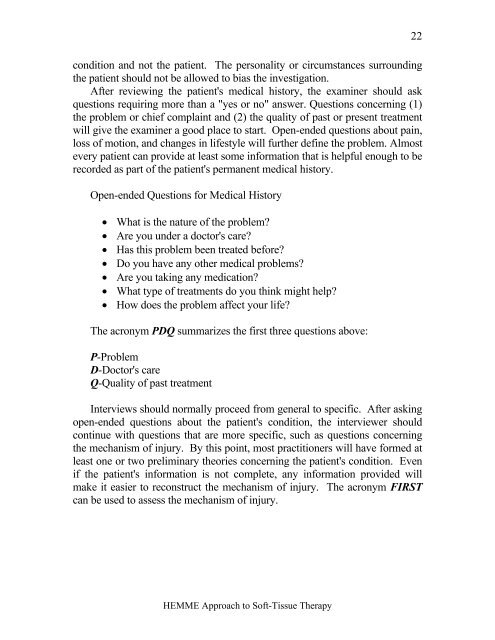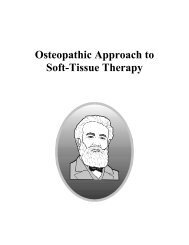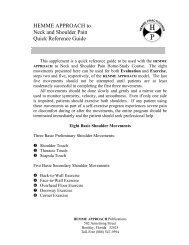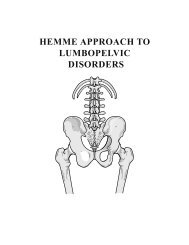HEMME APPROACH TO SOFT-TISSUE THERAPY
HEMME APPROACH TO SOFT-TISSUE THERAPY
HEMME APPROACH TO SOFT-TISSUE THERAPY
Create successful ePaper yourself
Turn your PDF publications into a flip-book with our unique Google optimized e-Paper software.
condition and not the patient. The personality or circumstances surrounding<br />
the patient should not be allowed to bias the investigation.<br />
After reviewing the patient's medical history, the examiner should ask<br />
questions requiring more than a "yes or no" answer. Questions concerning (1)<br />
the problem or chief complaint and (2) the quality of past or present treatment<br />
will give the examiner a good place to start. Open-ended questions about pain,<br />
loss of motion, and changes in lifestyle will further define the problem. Almost<br />
every patient can provide at least some information that is helpful enough to be<br />
recorded as part of the patient's permanent medical history.<br />
Open-ended Questions for Medical History<br />
• What is the nature of the problem?<br />
• Are you under a doctor's care?<br />
• Has this problem been treated before?<br />
• Do you have any other medical problems?<br />
• Are you taking any medication?<br />
• What type of treatments do you think might help?<br />
• How does the problem affect your life?<br />
The acronym PDQ summarizes the first three questions above:<br />
P-Problem<br />
D-Doctor's care<br />
Q-Quality of past treatment<br />
Interviews should normally proceed from general to specific. After asking<br />
open-ended questions about the patient's condition, the interviewer should<br />
continue with questions that are more specific, such as questions concerning<br />
the mechanism of injury. By this point, most practitioners will have formed at<br />
least one or two preliminary theories concerning the patient's condition. Even<br />
if the patient's information is not complete, any information provided will<br />
make it easier to reconstruct the mechanism of injury. The acronym FIRST<br />
can be used to assess the mechanism of injury.<br />
22<br />
<strong>HEMME</strong> Approach to Soft-Tissue Therapy









